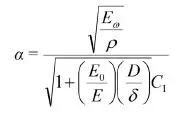2. Model establishment and basic parameters of the the water hammer
2.1 Establishment of the model of the water hammer
In view of the great harm caused by the water hammer, the water hammer protection measures need to be taken, and the water hammer calculations can provide a theoretical basis for subsequent the water hammer protection. The calculated maximum internal water pressure can be used as the basis for designing or checking the strength of the pipeline, and the calculated minimum internal water pressure can provide a basis for preventing negative pressure in the pressure pipeline. Combined with the project data, the Bentley HAMMER V8i the water hammer simulation software was used to establish a calculation model for the the water hammer.
2.2 Basic parameters of the water hammer
The wave velocity of the water hammer is an important parameter for analyzing the water hammer problems, which is mainly affected by many factors such as pipe diameters, pipe wall thickness and water elastic coefficient. The calculation formula of wave velocity of the water hammer is as follows:
 (1)
(1)In this formula,
In the formula, L is the total length of the pipeline (m); α is the wave velocity of the water hammer (m/s). The lengths of the two pipe sections are 7500 m and 10000 m respectively, and the phase lengths of the water hammer of the two pipe sections are 13.5s and 18.0s respectively.
3. Calculation results of steady-state the water hammer and the stopped pump
3.1 Steady-state calculation results
(1) From the pressure release section to the pumping station, the lowest point in the pipe is K4 plus 797, and the elevation is -8.5 m. At this time, the steady-state pressure head is 17.61 m; at the point of K0 plus 009, the steady-state highest pressure water head is 19.30 m. At this time, the steady-state water head is 19.30 m, and the pipe elevation is 0 m; at the end of the pipeline, the steady-state pressure head is 0.12 m, and the steady-state water head is 4.50 m; the pipe elevation is 4.38 m.
(2) From the pumping station to the sewage treatment plant section, the lowest point of the pipe elevation is K4 plus 797, and the elevation is -8.5 m. At this time, the steady-state pressure head is 20.29 m; at the point of K0 plus 009, the steady-state highest pressure water head is 22.01 m. At this time, the steady-state water head is 22.01 m, and the pipe elevation is 0 m; at the end of the pipeline, the steady-state pressure head is 0.50 m, and the steady-state water head is 3.50 m; the tube elevation is 3 m.
3.2 Calculation results of the water hammer of stopped pumps
(1) Under unprotected conditions, the the water hammer calculation results of the pump station to pressure release point section showed that the maximum pressure head of the entire pipeline appeared at the point of K0 plus 319, which is 142.30 m and about 7 times higher than the rated pressure of the pump outlet. It is much higher than 1.5 times the pressure specified in the Design Specifications of Pumping Stations in GB 50265-2010. Therefore, if there are no protective measures, when the pump is stopped due to an accident, the positive pressure of the pipeline will be too high, causing the pipeline to burst easily. The minimum pressure head appeared at the point of K4 plus 798, which is -3.61 m. The negative pressure value is high, and the maximum air volume is 89770L, which is prone to the water hammer, and is not conducive to the safe and stable operation of the pipeline.
(2) Under unprotected conditions, the the water hammer calculation results of the pumping station-sewage treatment plant section showed that the maximum pressure head of the entire pipeline appears at point K0 plus 319, which is 144.45m and about 6.4 times the rated pressure of the pump outlet. The smallest pressure head appeared at the point of K6 plus 172, which is -4.24 m, and the negative pressure value was relatively high. The maximum air volume is 37974L, which is prone to the the water hammer and not beneficial to the safe and stable operation of the pipeline.